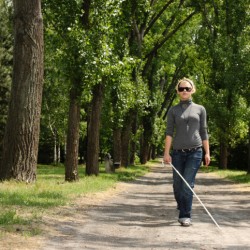Echolocation is a kind of sonar commonly associated with bats and
dolphins, who use echolocation to navigate the world and communicate
with others. Because human ears aren’t as sensitive as many animals’
ears, echolocation in humans might seem like a supernatural myth rather
than a scientific reality. The human body, though, is incredibly adept
at adapting to its environment, and blind people must find ways to
compensate for their lack of sight. According to a study recently
published in Psychological Science, some blind people rely on
echolocation. For some, echolocation is so effective that it completely
compensates for the lack of sight.

How the Blind Use Echolocation
Echolocation relies on the production of sound to gain information about objects. A person who echolocates produces subtle—and often inaudible—noises. Those sounds bounce off of nearby objects, and the returning sound waves provide information about the location of nearby objects. To determine whether blind people engage in this form of sonar production, researchers tested them for a common illusion. The Charpentier illusion occurs when people perceive a smaller object as heavier than a larger one.
Researchers presented three groups of participants with three cubes of different sizes. The cubes weighed the same, but participants could only lift them by pulling a string attached to each cube. The first group were blind but did not use echolocation, while the second group consisted of blind echolocators who relied on tongue clicks and finger snaps. A third group had no visual impairments.
Researchers found that the blind group that did not use echolocation
successfully judged the cubes as weighing the same. Both the sighted
group and the blind group that relied on echolocation, though,
experienced the smallest box as the heaviest. These results suggest that
echolocation mimics the sensory effects of vision, since both sighted
people and blind people who relied on echolocation were vulnerable to
the illusion. Previous research by the same team suggests that blind
people may use brain regions associated with vision while engaged in
echolocation.
You can view a real-life example of human echolocation
You can view a real-life example of human echolocation
https://www.youtube.com/watch?v=WHYCs8xtzUI
References:
Echolocation: A ‘sixth sense’ for blind people. (2014, December 26). Retrieved from http://www.medicalnewstoday.com/articles/287405.php
Source: Good Therapy, 30th Dec 2014

No comments:
Post a Comment